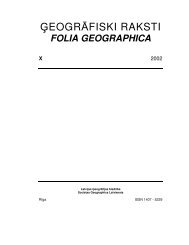eogrÄfiski raksti folia geographica xii - Ä¢eogrÄfijas un Zemes zinÄtņu ...
eogrÄfiski raksti folia geographica xii - Ä¢eogrÄfijas un Zemes zinÄtņu ...
eogrÄfiski raksti folia geographica xii - Ä¢eogrÄfijas un Zemes zinÄtņu ...
You also want an ePaper? Increase the reach of your titles
YUMPU automatically turns print PDFs into web optimized ePapers that Google loves.
37<br />
NATURE RESEARCH<br />
Thus, setting in of P+A period may occur rather rapidly, <strong>un</strong>less delayed by Old Wives’<br />
summer, a weather singularity, which then makes the transition period more gradual. Full<br />
autumn may also bring summer-in-autumn or “Old Wives’ summer’, which may occur several<br />
times or none at all as seen above. Such weather occurred in the first half of October in 1991,<br />
1995, 2000. For instance, in the period from 6th to 13th October 1991, warmed continental<br />
subpolar air cPs was brought into Latvia, when an anticyclone dominated over the European part<br />
of Russia. Warm, s<strong>un</strong>ny weather set in with great diurnal temperature variations. During<br />
daytime, the air temperature increased to +18° to +22°C, but at night, because of strong<br />
radiation cooling, the temperature was aro<strong>un</strong>d +4° to +9°C. Another episode was in the first<br />
half of October 1995, when an anticyclone formed in very warm air masses, south-western<br />
winds brought continental and transformed maritime mid-latitude air (cSp, xSp), and warm<br />
weather prevailed. On 10th October the temperature increased to +20° to +23°C, which was<br />
close to absolute maximum of October, and for several days aro<strong>un</strong>d that date a period of Old<br />
Wives’ summer occurred.<br />
In general, during the 11-year period, October was the wettest month. Full autumn<br />
showed high annual variation of arctic and warm mid-latitude air mass frequency, yet<br />
interannual variation of October’s average temperature was moderate. The standard deviation of<br />
near-surface monthly air temperatures and 850hPa pseudopotential temperatures were also<br />
moderate (Figures 7, 8, Table 5).<br />
Pre-winter, PW (end of October to end of November)<br />
Pre-winter marks the beginning of solar winter. The incoming short-wave radiation<br />
continues decreasing and during the 11-year period (1990-2000) the November average was 49<br />
MJ/m², which was half of that in October. Although occasionally Rnt may be close to zero or<br />
slightly above zero, in most cases it is negative. Regardless of that the diurnal air temperature<br />
commonly still remains positive. During PW the landscape comes to winter dormancy.<br />
In PW, maritime subpolar air mP and its first modification xP air dominated in one third<br />
of days, comprising together 32% (fronts excluded). Both manifested themselves as temperate<br />
air. The mP air commonly arrives behind the cold front of a cyclone and brings mild ( > 0°C) air<br />
temperatures. It is an <strong>un</strong>stable air mass and brings greatly changeable weather: clouds (mainly<br />
cumulus forms), sleet, snowfalls and then briefly clear skies. The xP air is more stable.<br />
Table 5<br />
Average annual frequency of air masses over Latvia (1990-2000)<br />
Air mass<br />
types<br />
1990 1991 1992 1993 1994 1995 1996 1997 1998 1999 2000 AVG STDEV<br />
cA 1 1 0.2<br />
xA 3 9 13 10 13 10 17 35 26 17 15 15.5 8.8<br />
mA 23 33 38 36 33 35 26 33 22 24 26 30 5.6<br />
cP 15 25 15 29 27 18 40 16 33 22 13 23 8.6<br />
xP 36 40 37 53 37 30 48 38 42 63 54 43.5 9.8<br />
mP 72 50 59 54 56 66 51 50 70 51 73 60 8.7<br />
cPs 31 32 34 25 20 19 30 18 14 19 24 24 6.4<br />
xPs 43 46 43 35 41 37 34 42 36 36 43 40 3.9<br />
mPs 11 15 11 13 16 8 12 13 8 14 16 13 2.7<br />
mSp 14 15 12 13 14 18 8 13 13 11 5 12 3.7<br />
xSp 15 24 19 14 23 29 18 28 14 20 20 20 5.1<br />
cSp 10 5 7 19 12 13 7 7 9 5 3 9 4.6<br />
mS 3 4 2 1 2 9 4 4 3 2 2 3 2.1<br />
xS 5 5 8 3 7 13 11 5 9 20 12 9 5<br />
cS 3 1 4 2 1 1.5<br />
fronts 72 62 67 60 60 60 57 63 66 61 59 62<br />
In the context of air masses, PW can be called a winter season, because the winter air<br />
masses gain the upper hand over warmer air masses, and during the 11-year period these (xA,<br />
mA, cP) comprised altogether on average 40%. Sleet and slush occurred almost each year. Prewinter<br />
is known for establishing of first snow cover, which lasts for at least one, but commonly

















